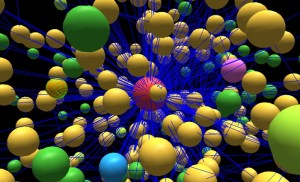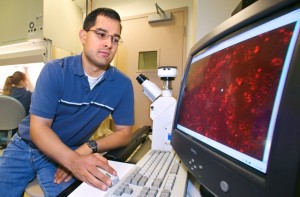
Systems biology is the classic whole being greater than the sum of its parts, where researchers seek to understand how complex organisms emerge from the interactions of the individual elements that make up its constituent cells.
Systems biology is a holistic approach to the study of how a living organism emerges from the interactions of the individual elements that make up its constituent cells. Embracing a broad range of disciplines, this field of science that is just beginning to come into public prominence holds promise for advances in a number of important areas, including safer, more effective pharmaceuticals, improved environmental remediation, and clean, green, sustainable energy. However, the most profound impact of systems biology, according to one of its foremost practitioners, is that it might one day provide an answer to the central question: What is life?
Adam Arkin, director of the Physical Biosciences Division of the U.S. Department of Energy (DOE)’s Lawrence Berkeley National Laboratory and a leading computational biologist, is the corresponding author of an essay in the journal Cell which describes in detail key technologies and insights that are advancing systems biology research. The paper is titled “Network News:Innovations in 21st Century Systems Biology.” Co-authoring the article is David Schaffer, a chemical engineer with Berkeley Lab’s Physical Biosciences Division. Both Arkin and Schaffer also hold appointments with the University of California (UC) Berkeley.
“System biology aims to understand how individual elements of the cell generate behaviors that allow survival in changeable environments, and collective cellular organization into structured communities,” Arkin says. “Ultimately, these cellular networks assemble into larger population networks to form large-scale ecologies and thinking machines, such as humans.”
In their essay, Arkin and Schaffer argue that the ideas behind systems biology originated more than a century ago and that the field should be viewed as “a mature synthesis of thought about the implications of biological structure and its dynamic organization.” Research into the evolution, architecture, and function of cells and cellular networks in combination with ever expanding computational power has led to predictive genome-scale regulatory and metabolic models of organisms. Today systems biology is ready to “bridge the gap between correlative analysis and mechanistic insights” that can transform biology from a descriptive science to an engineering science.
Discoveries in systems biology, the authors say, can generally be divided between those that relied on a “mechanistic approach to causal relationships,” and those that relied on “large-scale correlation analysis.” The results of these discoveries can also be categorized according to whether they primarily pertained to the principles behind cellular network organization, or to predictions about the behavior of these networks.
“As systems biology matures, the number of studies linking correlation with causation and principles with prediction will continue to grow,” Schaffer says. “Advances in measurement technologies that enable large-scale experiments across an array of parameters and conditions will increasingly meld these correlative and causal approaches, including correlative analyses leading to mechanistic hypothesis testing, as well as causal models empowered with sufficient data to make predictions.”
As the complete genomes of more organisms are sequenced, and measurement and genetic manipulation technologies are improved, scientists will be able to compare systems across a broader expanse of phylogenetic trees. This, Arkin and Schaffer say, will enhance our understanding of mechanistic features that are necessary for function and evolution.
“The increasing integration of experimental and computational technologies will thus corroborate, deepen, and diversify the theories that the earliest systems biologists used logic to infer,” Arkin says. “This will thereby inch us ever closer to answering the What is Life question.”
The systems biology research cited in this essay by Arkin and Schaffer was supported by DOE’s Office of Science (Biological and Environmental Research), and by the National Institutes of Health.
Lawrence Berkeley National Laboratory is a U.S. Department of Energy (DOE) national laboratory managed by the University of California for the DOE Office of Science. Berkeley Lab provides solutions to the world’s most urgent scientific challenges including sustainable energy, climate change, human health, and a better understanding of matter and force in the universe. It is a world leader in improving our lives through team science, advanced computing, and innovative technology. Visit our Website at www.lbl.gov
Additional Information
For more about Berkeley Lab’s Physical Biosciences Division, visit the Website at http://pbd.lbl.gov/

